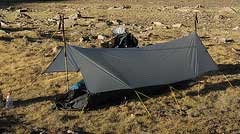 Tarp, bivy and tent footprint
Tarp, bivy and tent footprintBack when I bought my first backpacking tent at REI, I bought into the hype that by god if you put all this money into your backpacking tent, you need to protect that investment by buying a footprint to protect the tent’s floor. Well, if you camp out 300 nights a year it might be worth it, but no less a personage than Rick of Best Hikes fame once told me he never uses one, and he’s backpacked everywhere.
But a funny thing happened as my buyers’ remorse wore off: I found myself using the footprint far more often than the actual tent.
While a tent might weigh over 4 pounds, a footprint is 12 to 14 ounces of sturdy nylon you can use just about anywhere you need a layer between you and the ground. Granted it’s way heavier than Tyvek or a thin sheet of plastic, but it’s built not to wear out, so you’ll probably never need to buy another one.
When I decided my backpacking tent was too heavy and passed through my tarps-and-shelters phase, I tossed the tent’s footprint in my pack and always had a nice ground cloth. The picture above is the shelter setup I used on on my White Mountain adventure with Four Wheel Bob. It included a tarp, bivy and tent footprint, all weighing in at less than 2 pounds. Of course I could’ve had a much lighter shelter if I felt like buying more specialized gear, but I threw this kit together from stuff already in my gear closet, which strikes me as more practical/sustainable. (Standard caveat: your gear must match the conditions you expect.)
I’m still not sold on the idea of adding 30 bucks to the cost of a tent you might use three times a year, but I have no regrets about the footprint I ended up buying. If you’re spending a lot of time among desert thorns or camping out on rocky surfaces, then you might want to go ahead and shell out the extra bucks. Otherwise, though, your tent’s probably tough enough for soft dirt.
(Disclosure: I get a commission if you buy anything after clicking on my product links).
What about the rest of you? Share your wisdom in the comments.

Tom,
We don’t just a footprint when tenting either. In fact, we put our closed-cell foam pads UNDER the tent these days in leiu of carrying a groundcloth. It worked great for the 2 1/2 months it took for us to paddle the Mississippi, keeps the pads from running around during the night, and keeps the floor a bit dryer.
-John
I didn’t buy the footprint for my REI quarterdome, which I only pack if I think I might run into weather (in SoCal we rarely have weather). Instead I bought a $3.99 camo green tarp from Harbor Freight Tools.
Usually I just pack the tarp, which makes a nice ground cover. If I get caught in a storm I can pull it over me.
Two caveats, the poly threads are a little brittle and don’t stand up to a ton of abuse. Also, if you’re using a tarp as a tent footprint you have to make sure you fold the tarp so that it doesn’t become a rainwater collection & redistribution device – flooding the inside of your tent.
We use Tyvek – I needed some in a hurry one year, so bought a 9 ft wide roll from Home Depot. Now have enough for several lifetimes. Comes in handy for various purposes – snowcamping tarps, house projects, mattress cover for bed before grandchildren were house broken. I sell it at cost to the thru-hiker community in the spring, but closed for the season now. Too busy hiking to reliably ship it on time to anyone. As a ground cloth, it seems to last about 3 hiking seasons, then has enough worn creases & grass seeds to make me a little dubious about its water resistance.
My tent (golite utopia 2+) has a removable floor which I can find for about $35 on sale, so I never use a footprint/groundcloth – I figure if the floor ever gets damaged, I’ll buy a new one.
But if you are on the ground without a footprint or something similar and it rains, won’t you get wet? I just bought a ultra light tent for my kids and i to start backpacking (they’re finally getting old enough!) and i don’t really want the extra pound that a footprint would add, but i also don’t want them to be uncomfortable if the weather is bad. Any comments are appreciated! Thanks!
Inge
I can’t decide if I should use the footprint that came with my Big Agnes Seedhouse 1 Tent or not. It does add an extra 8-9 ounces to the tent but I’m going to be backpacking in the Northwest… so with rain and for extra protection for the floor I think it might be smart. Any ideas?